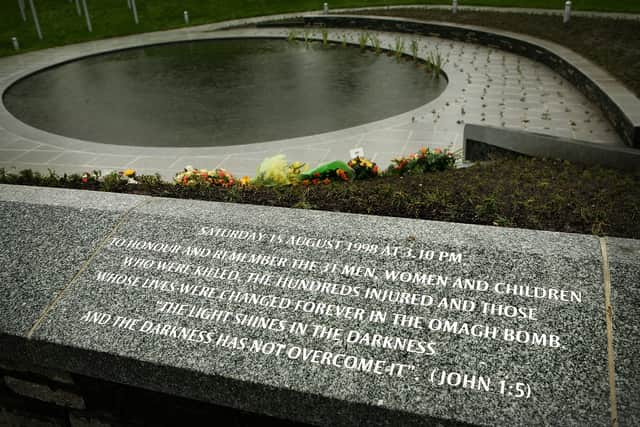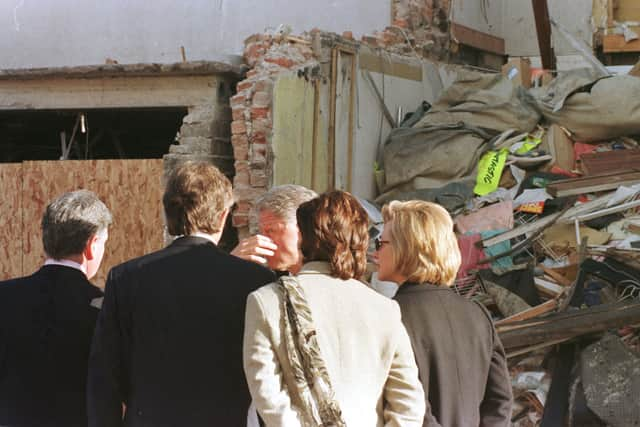Omagh bombing: What happened in Omagh in 1998 - as Northern Ireland marks 25th anniversary
and live on Freeview channel 276
A moment of silence has been held in Omagh as the Northern Ireland city marks the 25th anniversary of the Omagh bombing.
More than 100 people turned out to pay their respects, lining the street for the short ceremony, with some bereaved family members laying single white roses at the glass obelisk which marks the spot where the Real IRA attack occurred.
Advertisement
Hide AdAdvertisement
Hide AdThe atrocity took place in August 1998, just months after the historic signing of the Good Friday Agreement. It claimed the lives of 29 people, including a woman pregnant with twins, in what was the highest death toll in a single incident throughout the 30 years of The Troubles.
No one has ever been criminally convicted for the attack, with the UK government announcing in February that it would launch an independent, statutory inquiry to examine whether or not it could have been prevented.
What was the Omagh bombing?
On 15 August 1998 a bomb exploded in the County Tyrone city of Omagh, killing 29 people. The atrocity happened only four months after the historic signing of the Good Friday Agreement, which had finally brought about the end of the 30 year period of unrest known as The Troubles.


A newly formed dissident republican organisation calling itself the Real IRA claimed responsibility for the attack. Telephone warnings had been made to UTV and the Samaritans who both alerted the police, however, reported by the Irish Times, the location of the bomb was given as Main Street near the Omagh Courthouse, but there was no Main Street in the city. Police unknowingly evacuated civilians from High Street onto Market Street, which was where the bomb was located.
Advertisement
Hide AdAdvertisement
Hide AdOn the day following the attack, RUC chief constable Ronnie Flanagan told the press: “This is an attack, not carried out against the police or the army, but against the people of Omagh. We have had men, women and children slaughtered, slaughtered by murderers who want to murder, slaughtered by murderers who have nothing else to offer but murder, people who gave us a totally inaccurate warning, people who phoned to say there was a bomb close to the courthouse and as our officers searched and moved people from the area of the courthouse, a bomb detonated some 400 yards away.”
Who were the victims?
29 people, including a pregnant woman with twins lost their lives in the atrocity, in what was the single highest death toll in any attack during The Troubles. Over 200 people were also left injured. When the bomb hit, the town streets had been crowded with families who were shopping for the start of the new school term in September.


Has anyone ever been convicted for the Omagh bombing?
Following the attack, a newly formed dissident republican organisation calling itself the Real IRA claimed responsibility, but to date no one has ever been criminally prosecuted for the bombing.
The families who have lost loved ones have spent decades trying to bring those behind the atrocity to justice. In 2021 a court in Belfast ruled that it was possible the bombing could have been prevented. Reported by the BBC, Justice Mark Horner said in his ruling: “I am satisfied that certain grounds when considered separately or together give rise to plausible allegations that there was a real prospect of preventing the Omagh bombing.”
Advertisement
Hide AdAdvertisement
Hide AdIn February 2023, the UK government confirmed there would be an independent, statutory inquiry into the attack, with the secretary of state for Northern Ireland, Chris Heaton-Harris stating that the inquiry would look at the issues highlighted by the 2021 court case in Belfast, including whether or not the bombing could have been prevented.
Comment Guidelines
National World encourages reader discussion on our stories. User feedback, insights and back-and-forth exchanges add a rich layer of context to reporting. Please review our Community Guidelines before commenting.
